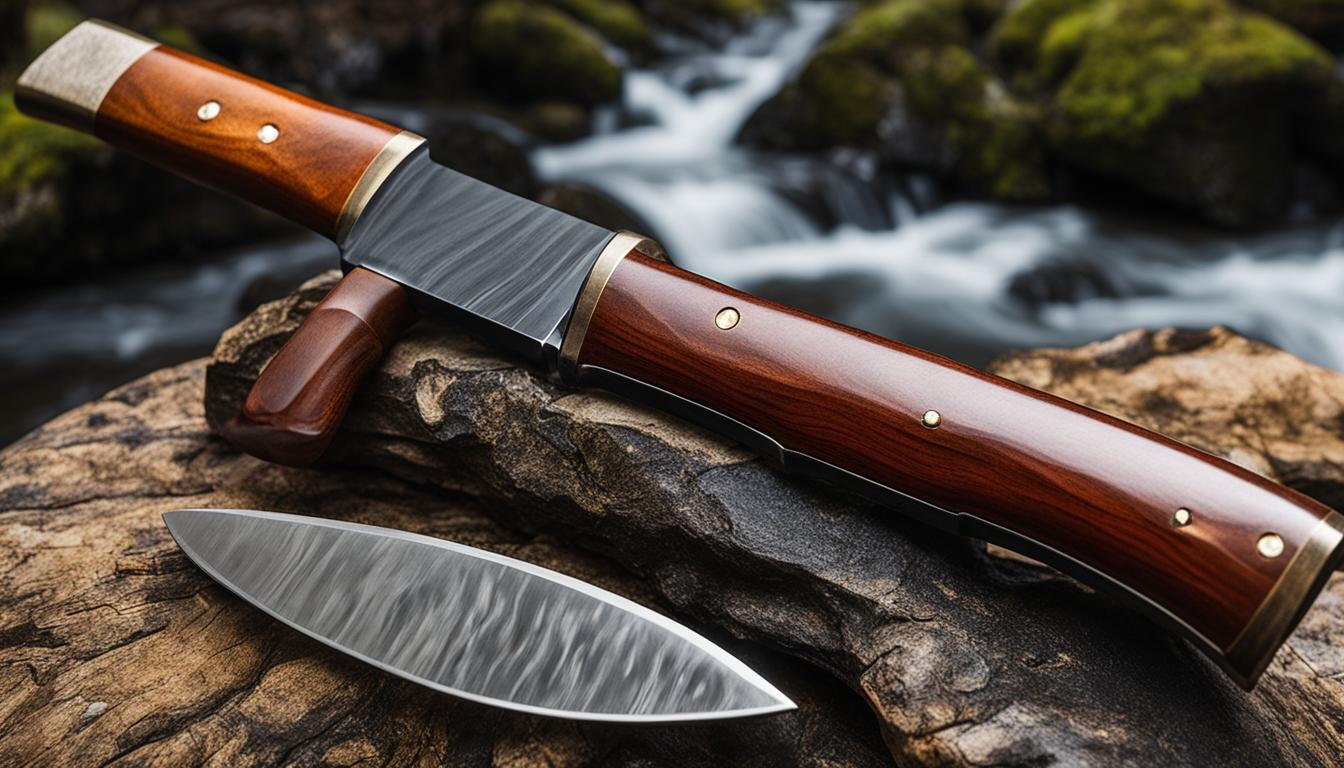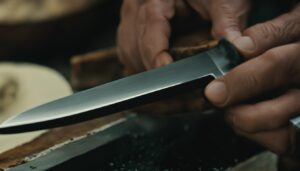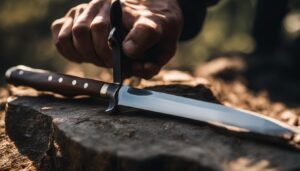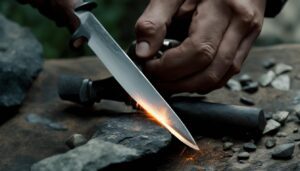Hunting knives are essential tools for hunters, but they can lose their sharpness over time. Maintaining your knife is crucial for retaining performance, durability, safety, and efficiency. Different types of hunting knives require different sharpening techniques. There are various types of sharpening tools available, including sharpening stones, honing rods, electric sharpeners, pull-through sharpeners, and guided sharpening systems. Before sharpening your hunting knife, clean the blade, check for damage, determine the correct angle, and choose the appropriate sharpening method.
Key Takeaways:
- Regular maintenance is essential for retaining the performance and longevity of your hunting knife.
- Different types of hunting knives require different sharpening techniques.
- Cleaning the blade and checking for damage before sharpening is important.
- Choosing the right sharpening tool and maintaining a consistent angle is crucial for optimal results.
- Proper care and storage practices contribute to the longevity and performance of your hunting knife.
Understanding the Grind and Profile of Your Hunting Knife
When it comes to hunting knives, understanding the grind and profile is essential for choosing the right tool and maintaining its performance. The grind of a knife refers to the slope or thinning of the steel towards the edge, while the profile relates to the shape of the blade. Let’s explore the various grind types and knife profiles commonly used in hunting.
Blade Grind Types
There are several grind types used in hunting knives, each with its own strengths and weaknesses. Here are the most common ones:
- Full Flat Grind: This grind type features a continuous slope from the spine to the edge, resulting in excellent cutting ability and ease of sharpening.
- Sabre Grind: With a thicker blade at the spine and a more gradual slope towards the edge, the sabre grind provides added durability and cutting power at the expense of some slicing ability.
- Hollow Grind: Characterized by a concave slope from the spine to the edge, the hollow grind offers exceptional cutting performance and is often used in razor-sharp blades. However, it may be less durable.
- Convex Grind: This grind type features a convex curve, with the blade thicker towards the edge. It provides durability and slicing ability, making it suitable for heavy-duty tasks.
- Scandinavian Grind: Popular in Nordic knives, the Scandinavian grind has a flat primary bevel and a secondary bevel, offering excellent control for precise tasks like carving and woodworking.
Knife Profiles
The profile of a hunting knife refers to the shape of the blade, influencing its cutting and piercing abilities. Here are some commonly used profiles:
- Drop Point: The drop point profile features a convex curve on the spine, allowing for a broad and durable tip. It offers excellent control and versatility, making it suitable for a wide range of hunting tasks.
- Clip Point: With a concave curve on the spine and a sharply pointed tip, the clip point profile provides superior piercing ability. It’s commonly used for detailed work and precision cutting.
- Spear Point: This profile has a symmetrical double-edged blade with a sharp point, making it ideal for piercing and thrusting actions. It’s commonly seen in tactical and combat knives.
- Scandinavian: The Scandinavian profile features a straight edge with a flat or slightly convex curve. It’s known for its durability and ease of sharpening, making it popular among bushcraft enthusiasts.
Understanding the grind and profile of your hunting knife is essential for choosing the right tool for the task at hand. It also helps in proper maintenance and sharpening techniques to ensure the longevity and performance of your knife.
Cleaning and Maintenance Tips for Your Hunting Knife
Proper cleaning and maintenance are essential for keeping your hunting knife in top condition. Regularly cleaning your knife not only helps to maintain its performance but also prolongs its lifespan. Here are some tips to ensure you take good care of your hunting knife:
- Clean the blade: Start by removing any dirt, debris, or residue from the blade. Rinse it with warm water and use a mild dish soap to clean it thoroughly. Avoid using abrasive cleaners or scrub brushes that could scratch the blade.
- Handle care: The handle of your hunting knife also requires attention. Depending on the material, you can clean it using a damp cloth with a mild soap solution. If your knife has a wooden handle, be careful not to saturate it with water as this can cause damage.
- Dry thoroughly: After cleaning, make sure to dry your hunting knife thoroughly to prevent any moisture from causing rust or corrosion. Use a clean towel or cloth to remove all moisture from the blade and handle.
- Apply oil: To protect the blade from rust, apply a thin coat of oil after cleaning and drying. You can use a specialized knife oil or even mineral oil as a rust preventative. Make sure to wipe off any excess oil to avoid attracting dirt or debris.
- Sharpen regularly: Keeping your hunting knife sharp is crucial for its performance. Regularly check the blade’s sharpness and use sharpening tools to maintain the edge. Refer to Section 5 for recommended sharpening tools.
By following these cleaning and maintenance tips, you can ensure that your hunting knife remains in optimal condition. Remember to inspect your knife regularly for any signs of wear or damage and address them promptly to avoid further issues. With proper care, your hunting knife can serve you well for many hunting seasons to come.
Quote:
“Proper cleaning and maintenance not only keep your hunting knife in top condition but also prolong its lifespan. Take care of your knife, and it will take care of you.” – HuntingKnifeExpert
Table: Hunting Knife Cleaning Guide
| Step | Description |
|---|---|
| 1 | Clean the blade with warm water and mild soap to remove dirt and residue. |
| 2 | Handle care: Clean the handle according to its material (e.g., damp cloth for synthetic handles, minimal water for wooden handles). |
| 3 | Dry the knife thoroughly with a clean towel or cloth to prevent rust and corrosion. |
| 4 | Apply a thin coat of oil to the blade to protect against rust. |
| 5 | Regularly inspect and sharpen the blade to maintain its sharpness. |
Remember to always prioritize safety when cleaning and handling your hunting knife. Use caution and follow the manufacturer’s instructions for specific care recommendations. With proper cleaning and maintenance, your hunting knife will remain a reliable tool for all your outdoor adventures.
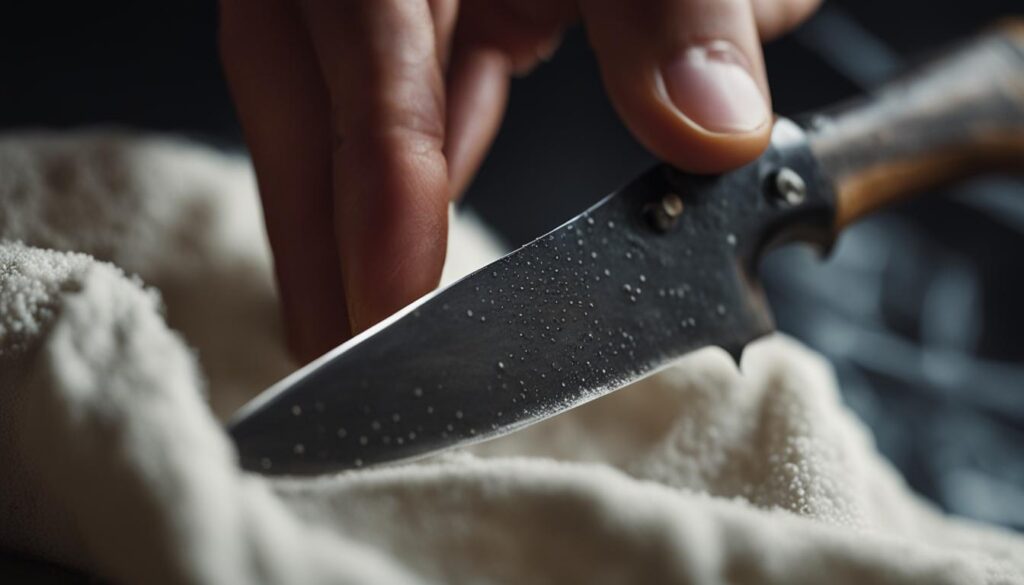
Proper Storage and Handling of Your Hunting Knife
Proper storage and handling practices are essential to ensure the longevity and safety of your hunting knife. By following these guidelines, you can protect your knife from damage, maintain its sharpness, and prevent accidents.
Knife Storage:
When it comes to storing your hunting knife, it’s important to keep it in a dry place, away from humidity and moisture. Exposure to damp conditions can lead to rust and corrosion, compromising the blade’s integrity. Consider using a leather sheath or a wooden block to store your knife, as these materials provide excellent protection against moisture while allowing proper airflow.
Additionally, avoid storing your knife in extreme temperatures, as this can negatively impact the blade’s performance. Extreme cold can make the blade more brittle, while extreme heat can cause the handle materials to warp or degrade.
Proper knife storage not only preserves the knife’s condition but also reduces the risk of accidental cuts or injuries when reaching for the knife.
Knife Handling Best Practices:
When handling your hunting knife, always prioritize safety. Follow these best practices to ensure safe and effective use of your knife:
- Never use your hunting knife for tasks it’s not intended for, such as prying or opening cans. Misusing your knife can damage the blade or cause the handle to loosen.
- Always hold the knife securely, maintaining a firm grip on the handle to prevent accidental slips.
- Use a honing rod to maintain the blade’s sharpness between regular sharpenings. A honing rod helps align the blade’s edge, keeping it in optimal cutting condition.
- Regularly inspect your knife for any signs of damage, such as chips or cracks in the blade. If you notice any issues, refrain from using the knife until it’s repaired or replaced.
By following these storage and handling practices, you can ensure that your hunting knife remains in top shape, ready for your next outdoor adventure.
Recommended Sharpening Tools for Hunting Knives
Properly sharpening your hunting knife is essential for maintaining its cutting performance and prolonging its lifespan. To achieve optimal results, it’s important to choose the right sharpening tool based on your skill level and the type of knife you have. Below are some of the recommended sharpening tools for hunting knives:
Sharpening Stones
Sharpening stones, also known as whetstones, are versatile and widely used tools for sharpening hunting knives. They come in various materials, such as natural stone, diamond stone, ceramic stone, and synthetic stone. Each type of stone has its own qualities and benefits. For example, natural stones are known for their ability to produce a refined edge, while diamond stones are highly durable and suitable for heavy-duty sharpening. Ceramic stones are popular for their consistent performance, and synthetic stones are affordable and easy to use.
Honing Rod
A honing rod is a long, cylindrical rod made of steel or ceramic that helps straighten the edge of your hunting knife. It is a useful tool for maintaining the sharpness of the blade between sharpenings. By running the knife blade along the honing rod at a consistent angle, you can realign the microscopic teeth on the edge, resulting in a sharper cutting edge. Honing rods are available in different lengths and materials, and they are often used in combination with sharpening stones for comprehensive knife maintenance.
Electric Sharpeners
If you prefer a fast and efficient sharpening process, an electric sharpener can be a convenient option. Electric sharpeners are equipped with abrasive belts or discs that remove material from the blade to restore its sharpness. They are suitable for both beginners and experienced users, providing consistent and precise sharpening results. Electric sharpeners offer different grit options and adjustable sharpening angles to accommodate various blade types and user preferences.
Pull-Through Sharpeners
Pull-through sharpeners are compact and portable tools that consist of two sharpening stones set at a specific angle. They are designed for easy and quick sharpening, making them ideal for hunters who need to touch up their knives while on the go. Pull-through sharpeners are user-friendly, allowing you to slide the blade through the slots to restore its sharpness. They come in different designs and with varying grits, catering to different blade conditions and sharpening requirements.
When selecting a sharpening tool, consider your skill level, the type of knife you own, and the desired sharpening results. It’s important to follow the manufacturer’s instructions and practice proper sharpening techniques to maintain the integrity of your hunting knife’s blade. By using the right sharpening tools and regularly maintaining your knife’s edge, you can ensure its optimal cutting performance and enjoy a reliable tool for your hunting adventures.
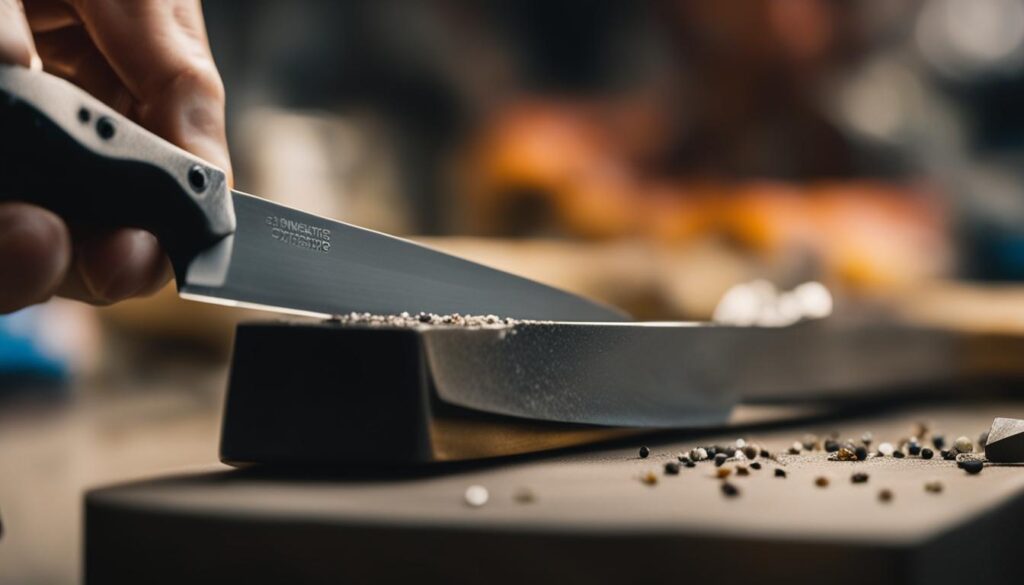

Conclusion
In conclusion, maintaining your hunting knife is essential for optimal performance and safety. By understanding the grind and profile of your knife, you can choose the right knife for specific tasks and sharpen and maintain it properly.
Regular cleaning and routine maintenance, such as evaluating the blade, removing rust, adding oil, and sharpening, are crucial for the longevity of your hunting knife. Additionally, proper storage and handling practices, along with the use of recommended sharpening tools, contribute to the sharpness and durability of your knife.
Following these knife care tips and sharpening techniques will ensure that your hunting knife is always in top shape for your next hunting expedition. Remember to clean, maintain, and store your knife properly to extend its lifespan and to enjoy its optimal performance for years to come.
FAQ
What are the essential tips for maintaining a hunting knife?
The essential tips for maintaining a hunting knife include regularly sharpening the blade, cleaning the knife after use, evaluating the blade for damage, and storing it properly.
How often should I sharpen my hunting knife?
The frequency of sharpening your hunting knife depends on how often you use it and the type of tasks you perform. Generally, it’s recommended to sharpen the blade whenever it starts to lose its sharpness.
How do I clean a hunting knife?
To clean a hunting knife, rinse it with warm water and scrub it lightly with soap. For deeper cleaning, you can use a baking soda paste. Thoroughly dry the knife after cleaning to prevent rust.
What is the best way to store a hunting knife?
It is best to store a hunting knife in a dry place, away from moisture and extreme temperatures. Leather sheaths or wooden blocks can be used for storage to protect the blade.
What are the recommended sharpening tools for hunting knives?
There are various sharpening tools available for hunting knives, including sharpening stones, honing rods, electric sharpeners, pull-through sharpeners, and guided sharpening systems. The choice depends on your skill level and the type of knife.
How do I choose the right sharpening tool for my hunting knife?
The right sharpening tool for your hunting knife depends on your skill level and the type of knife you have. It’s important to consider factors such as ease of use, consistency of sharpening angle, and the desired sharpness.
